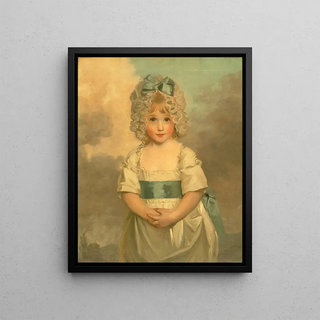Art print | Mademoiselle Charlotte Papendick enfant - John Hoppner


View from behind

Frame (optional)
In the fascinating world of art, some artworks stand out for their ability to capture innocence and childhood beauty. "Mademoiselle Charlotte Papendick enfant" by John Hoppner is one of those pieces that, through its timeless charm, transports the viewer to the heart of 18th-century England. This portrait, executed with remarkable finesse, evokes not only the appearance of a young girl but also the spirit of an era when art reflected societal morals and aspirations. Through Charlotte’s eyes, the painter invites us to explore a world filled with gentleness and delicacy, where every detail is carefully crafted to convey a palpable emotion.
Style and uniqueness of the work
John Hoppner’s style is characterized by an intimate approach and meticulous attention to detail. In "Mademoiselle Charlotte Papendick enfant," light plays a crucial role, illuminating the child's face with a tenderness that seems almost supernatural. The delicate nuances of the skin, the reflections in the blond hair, and the texture of the clothing are rendered with such precision that they appear alive. Hoppner excels in capturing expressions, and Charlotte’s gaze, both curious and dreamy, reveals a rare psychological depth for a childhood portrait. This artwork also stands out for its use of color, where pastel shades blend harmoniously to create a soft and soothing atmosphere. Every element of the painting, from the delicate background to the carefully chosen accessories, contributes to the overall harmony, making this piece a true masterpiece of portraiture.
The artist and his influence
John Hoppner, born in 1758, is one of the most renowned portraitists of his time, rivaling artists such as Sir Joshua Reynolds. His training, influenced by masters of European painting, allowed him to develop a unique style that combines tradition and innovation. Hoppner mastered capturing the essence of his subjects, endowing them with dignity and presence that transcend mere representation. His work not only influenced his contemporaries but also left a lasting mark on British portrait painting.

Matte finish

View from behind

Frame (optional)
In the fascinating world of art, some artworks stand out for their ability to capture innocence and childhood beauty. "Mademoiselle Charlotte Papendick enfant" by John Hoppner is one of those pieces that, through its timeless charm, transports the viewer to the heart of 18th-century England. This portrait, executed with remarkable finesse, evokes not only the appearance of a young girl but also the spirit of an era when art reflected societal morals and aspirations. Through Charlotte’s eyes, the painter invites us to explore a world filled with gentleness and delicacy, where every detail is carefully crafted to convey a palpable emotion.
Style and uniqueness of the work
John Hoppner’s style is characterized by an intimate approach and meticulous attention to detail. In "Mademoiselle Charlotte Papendick enfant," light plays a crucial role, illuminating the child's face with a tenderness that seems almost supernatural. The delicate nuances of the skin, the reflections in the blond hair, and the texture of the clothing are rendered with such precision that they appear alive. Hoppner excels in capturing expressions, and Charlotte’s gaze, both curious and dreamy, reveals a rare psychological depth for a childhood portrait. This artwork also stands out for its use of color, where pastel shades blend harmoniously to create a soft and soothing atmosphere. Every element of the painting, from the delicate background to the carefully chosen accessories, contributes to the overall harmony, making this piece a true masterpiece of portraiture.
The artist and his influence
John Hoppner, born in 1758, is one of the most renowned portraitists of his time, rivaling artists such as Sir Joshua Reynolds. His training, influenced by masters of European painting, allowed him to develop a unique style that combines tradition and innovation. Hoppner mastered capturing the essence of his subjects, endowing them with dignity and presence that transcend mere representation. His work not only influenced his contemporaries but also left a lasting mark on British portrait painting.






